Child Abuse Prevention: Annotated Bibliography & NAEYC Position
VerifiedAdded on 2023/03/31
|8
|1786
|123
Annotated Bibliography
AI Summary
This annotated bibliography provides a compilation of scholarly peer-reviewed sources relevant to child abuse and prevention, particularly in the context of the National Association for the Education of Young Children (NAEYC) position statement. The bibliography includes summaries of articles discussing topics such as the impact of early care and education on maltreated children's language development, the need for comprehensive training in child abuse recognition for dental students, the benefits of accredited childcare centers, the importance of appropriate touch in the classroom, and the role of pre-service teachers in addressing child sexual abuse. It also addresses emotional maltreatment in the classroom, the importance of health and safety in childcare, creating trauma-sensitive classrooms, and the implementation of NAEYC policies in schools. The resources aim to provide educators and caregivers with information and strategies to support children's well-being and prevent child abuse.
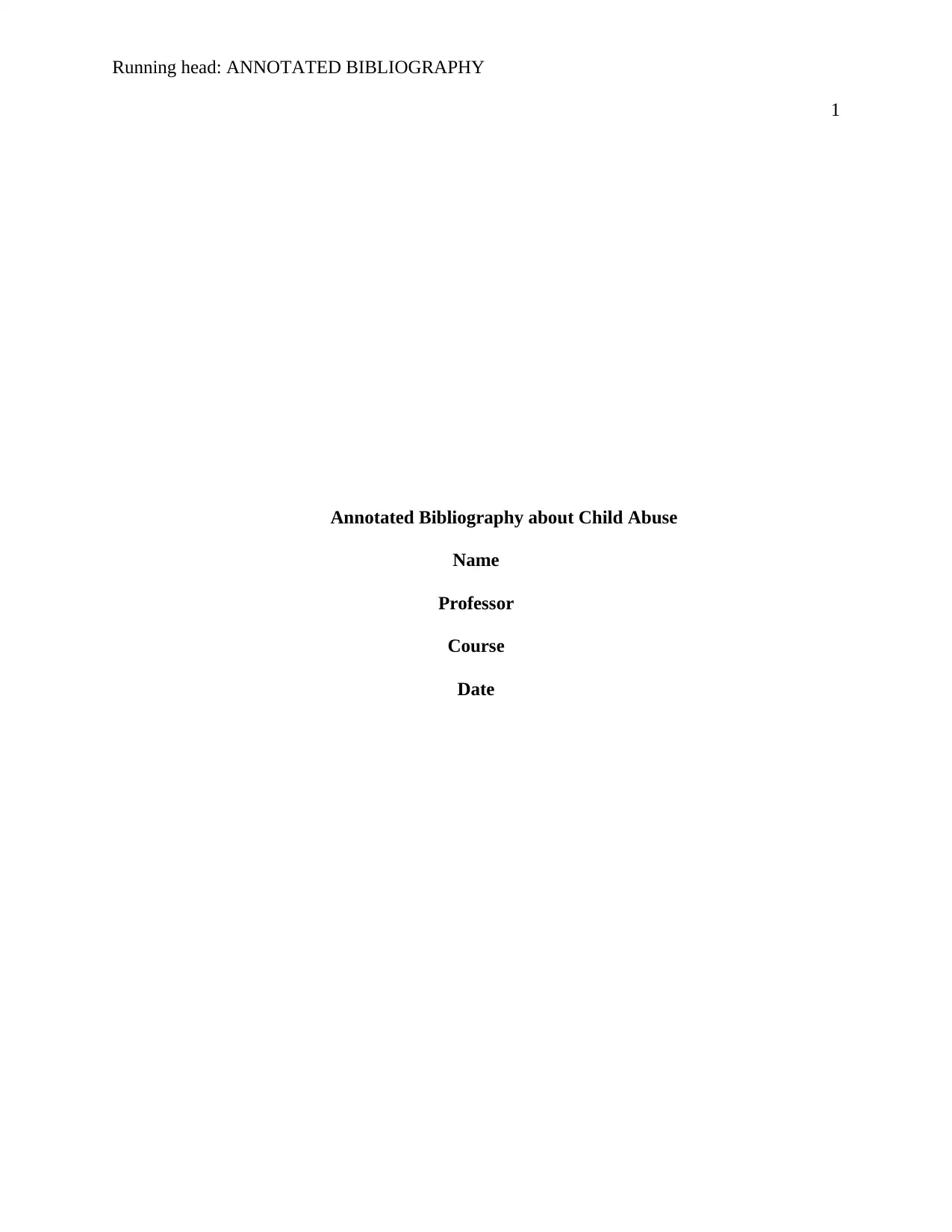
Running head: ANNOTATED BIBLIOGRAPHY
1
Annotated Bibliography about Child Abuse
Name
Professor
Course
Date
1
Annotated Bibliography about Child Abuse
Name
Professor
Course
Date
Paraphrase This Document
Need a fresh take? Get an instant paraphrase of this document with our AI Paraphraser
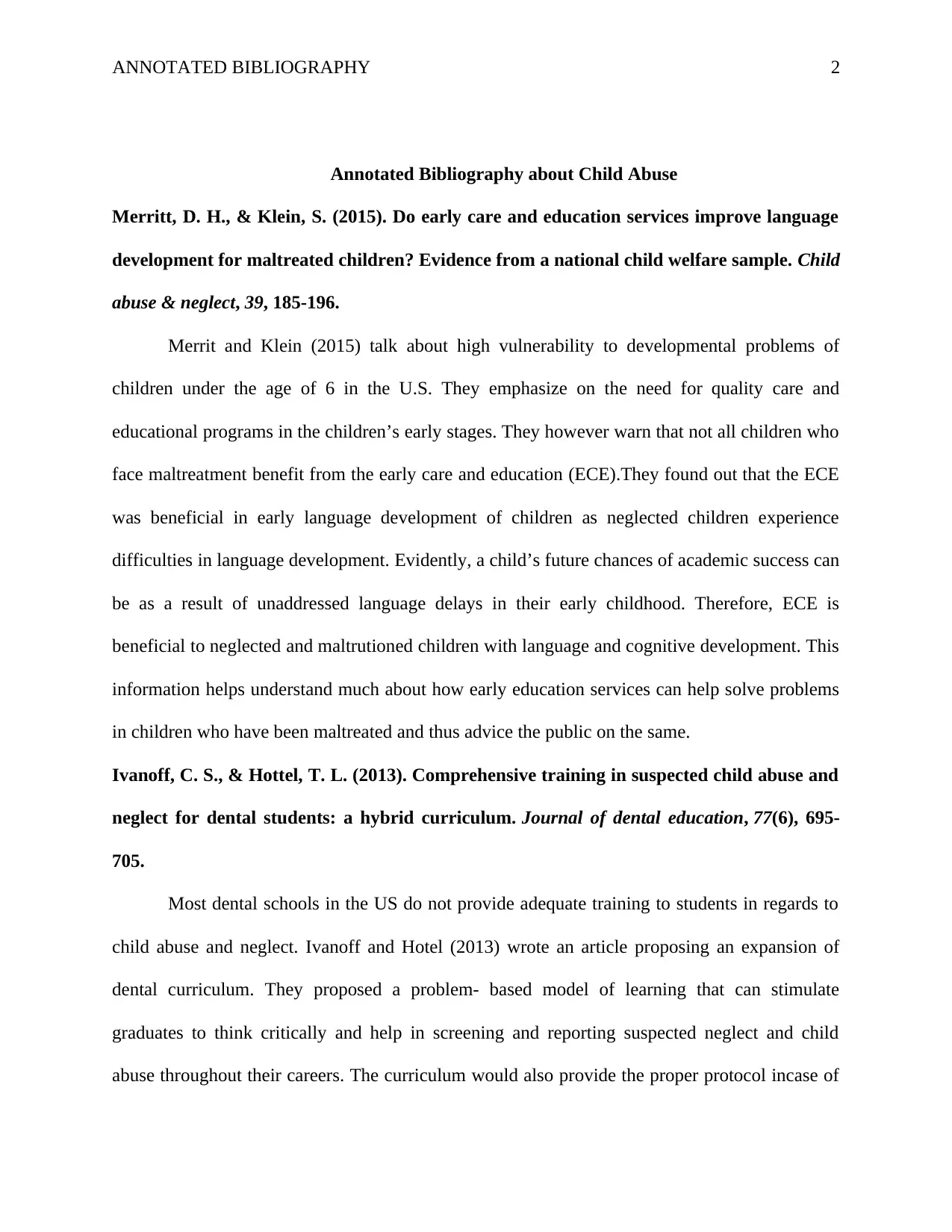
ANNOTATED BIBLIOGRAPHY 2
Annotated Bibliography about Child Abuse
Merritt, D. H., & Klein, S. (2015). Do early care and education services improve language
development for maltreated children? Evidence from a national child welfare sample. Child
abuse & neglect, 39, 185-196.
Merrit and Klein (2015) talk about high vulnerability to developmental problems of
children under the age of 6 in the U.S. They emphasize on the need for quality care and
educational programs in the children’s early stages. They however warn that not all children who
face maltreatment benefit from the early care and education (ECE).They found out that the ECE
was beneficial in early language development of children as neglected children experience
difficulties in language development. Evidently, a child’s future chances of academic success can
be as a result of unaddressed language delays in their early childhood. Therefore, ECE is
beneficial to neglected and maltrutioned children with language and cognitive development. This
information helps understand much about how early education services can help solve problems
in children who have been maltreated and thus advice the public on the same.
Ivanoff, C. S., & Hottel, T. L. (2013). Comprehensive training in suspected child abuse and
neglect for dental students: a hybrid curriculum. Journal of dental education, 77(6), 695-
705.
Most dental schools in the US do not provide adequate training to students in regards to
child abuse and neglect. Ivanoff and Hotel (2013) wrote an article proposing an expansion of
dental curriculum. They proposed a problem- based model of learning that can stimulate
graduates to think critically and help in screening and reporting suspected neglect and child
abuse throughout their careers. The curriculum would also provide the proper protocol incase of
Annotated Bibliography about Child Abuse
Merritt, D. H., & Klein, S. (2015). Do early care and education services improve language
development for maltreated children? Evidence from a national child welfare sample. Child
abuse & neglect, 39, 185-196.
Merrit and Klein (2015) talk about high vulnerability to developmental problems of
children under the age of 6 in the U.S. They emphasize on the need for quality care and
educational programs in the children’s early stages. They however warn that not all children who
face maltreatment benefit from the early care and education (ECE).They found out that the ECE
was beneficial in early language development of children as neglected children experience
difficulties in language development. Evidently, a child’s future chances of academic success can
be as a result of unaddressed language delays in their early childhood. Therefore, ECE is
beneficial to neglected and maltrutioned children with language and cognitive development. This
information helps understand much about how early education services can help solve problems
in children who have been maltreated and thus advice the public on the same.
Ivanoff, C. S., & Hottel, T. L. (2013). Comprehensive training in suspected child abuse and
neglect for dental students: a hybrid curriculum. Journal of dental education, 77(6), 695-
705.
Most dental schools in the US do not provide adequate training to students in regards to
child abuse and neglect. Ivanoff and Hotel (2013) wrote an article proposing an expansion of
dental curriculum. They proposed a problem- based model of learning that can stimulate
graduates to think critically and help in screening and reporting suspected neglect and child
abuse throughout their careers. The curriculum would also provide the proper protocol incase of
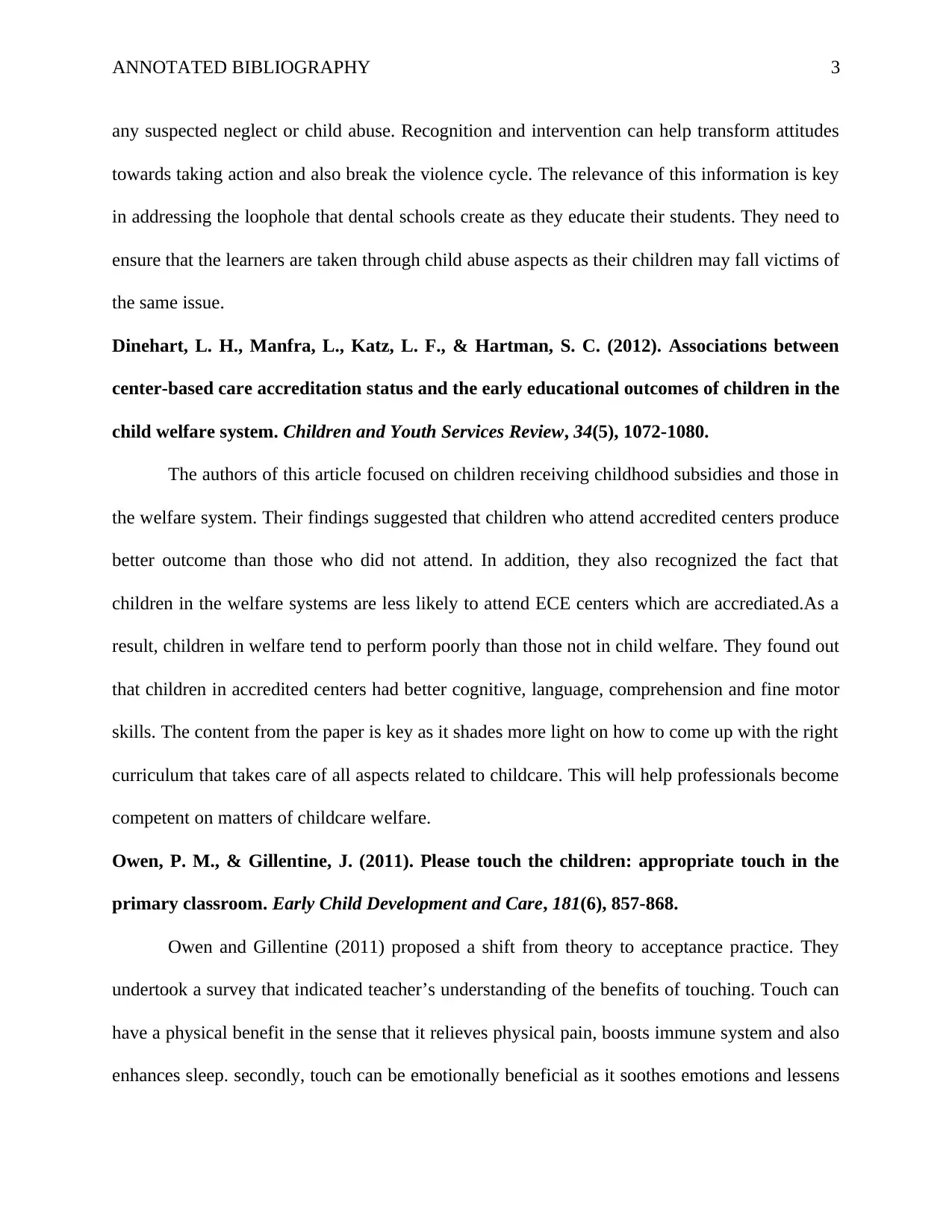
ANNOTATED BIBLIOGRAPHY 3
any suspected neglect or child abuse. Recognition and intervention can help transform attitudes
towards taking action and also break the violence cycle. The relevance of this information is key
in addressing the loophole that dental schools create as they educate their students. They need to
ensure that the learners are taken through child abuse aspects as their children may fall victims of
the same issue.
Dinehart, L. H., Manfra, L., Katz, L. F., & Hartman, S. C. (2012). Associations between
center-based care accreditation status and the early educational outcomes of children in the
child welfare system. Children and Youth Services Review, 34(5), 1072-1080.
The authors of this article focused on children receiving childhood subsidies and those in
the welfare system. Their findings suggested that children who attend accredited centers produce
better outcome than those who did not attend. In addition, they also recognized the fact that
children in the welfare systems are less likely to attend ECE centers which are accrediated.As a
result, children in welfare tend to perform poorly than those not in child welfare. They found out
that children in accredited centers had better cognitive, language, comprehension and fine motor
skills. The content from the paper is key as it shades more light on how to come up with the right
curriculum that takes care of all aspects related to childcare. This will help professionals become
competent on matters of childcare welfare.
Owen, P. M., & Gillentine, J. (2011). Please touch the children: appropriate touch in the
primary classroom. Early Child Development and Care, 181(6), 857-868.
Owen and Gillentine (2011) proposed a shift from theory to acceptance practice. They
undertook a survey that indicated teacher’s understanding of the benefits of touching. Touch can
have a physical benefit in the sense that it relieves physical pain, boosts immune system and also
enhances sleep. secondly, touch can be emotionally beneficial as it soothes emotions and lessens
any suspected neglect or child abuse. Recognition and intervention can help transform attitudes
towards taking action and also break the violence cycle. The relevance of this information is key
in addressing the loophole that dental schools create as they educate their students. They need to
ensure that the learners are taken through child abuse aspects as their children may fall victims of
the same issue.
Dinehart, L. H., Manfra, L., Katz, L. F., & Hartman, S. C. (2012). Associations between
center-based care accreditation status and the early educational outcomes of children in the
child welfare system. Children and Youth Services Review, 34(5), 1072-1080.
The authors of this article focused on children receiving childhood subsidies and those in
the welfare system. Their findings suggested that children who attend accredited centers produce
better outcome than those who did not attend. In addition, they also recognized the fact that
children in the welfare systems are less likely to attend ECE centers which are accrediated.As a
result, children in welfare tend to perform poorly than those not in child welfare. They found out
that children in accredited centers had better cognitive, language, comprehension and fine motor
skills. The content from the paper is key as it shades more light on how to come up with the right
curriculum that takes care of all aspects related to childcare. This will help professionals become
competent on matters of childcare welfare.
Owen, P. M., & Gillentine, J. (2011). Please touch the children: appropriate touch in the
primary classroom. Early Child Development and Care, 181(6), 857-868.
Owen and Gillentine (2011) proposed a shift from theory to acceptance practice. They
undertook a survey that indicated teacher’s understanding of the benefits of touching. Touch can
have a physical benefit in the sense that it relieves physical pain, boosts immune system and also
enhances sleep. secondly, touch can be emotionally beneficial as it soothes emotions and lessens
⊘ This is a preview!⊘
Do you want full access?
Subscribe today to unlock all pages.

Trusted by 1+ million students worldwide
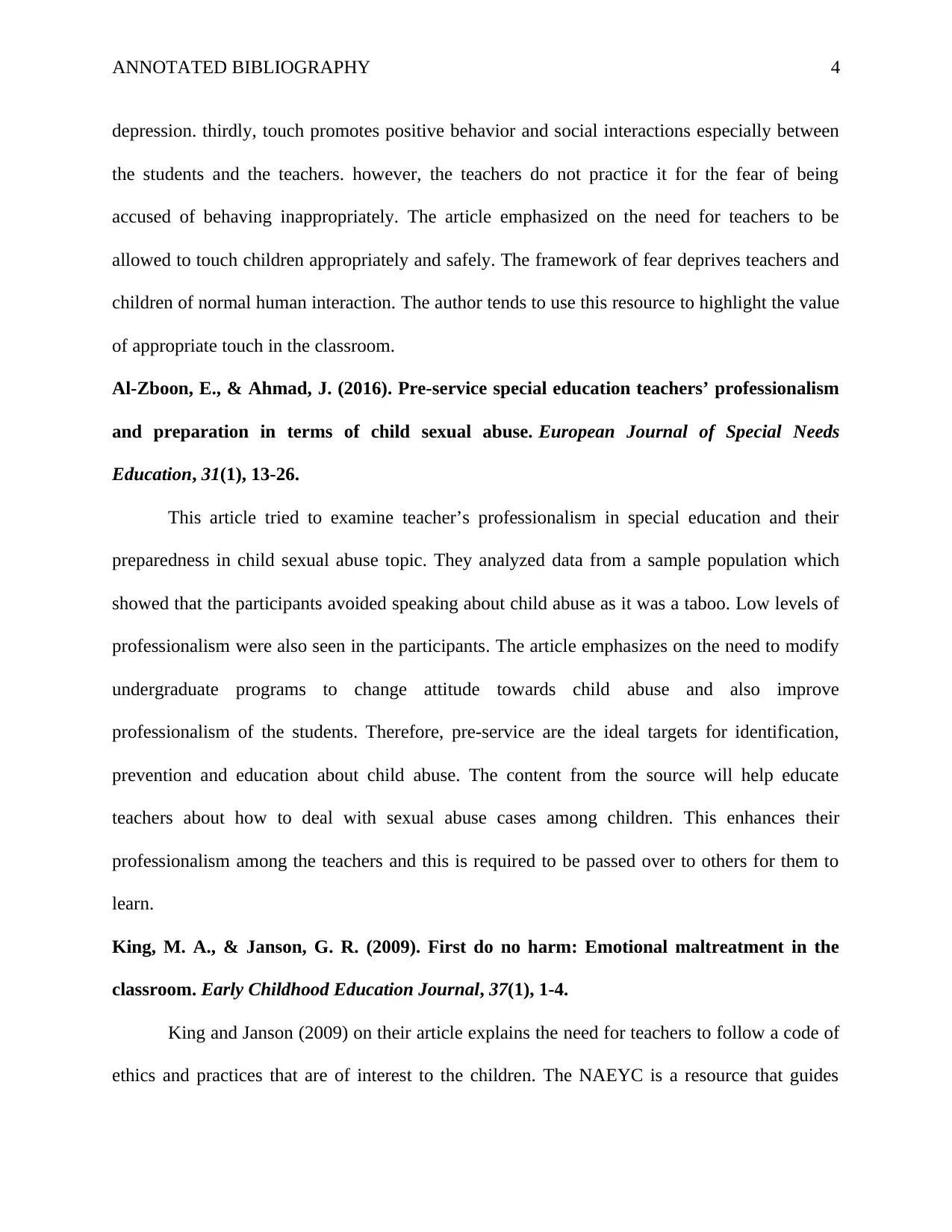
ANNOTATED BIBLIOGRAPHY 4
depression. thirdly, touch promotes positive behavior and social interactions especially between
the students and the teachers. however, the teachers do not practice it for the fear of being
accused of behaving inappropriately. The article emphasized on the need for teachers to be
allowed to touch children appropriately and safely. The framework of fear deprives teachers and
children of normal human interaction. The author tends to use this resource to highlight the value
of appropriate touch in the classroom.
Al-Zboon, E., & Ahmad, J. (2016). Pre-service special education teachers’ professionalism
and preparation in terms of child sexual abuse. European Journal of Special Needs
Education, 31(1), 13-26.
This article tried to examine teacher’s professionalism in special education and their
preparedness in child sexual abuse topic. They analyzed data from a sample population which
showed that the participants avoided speaking about child abuse as it was a taboo. Low levels of
professionalism were also seen in the participants. The article emphasizes on the need to modify
undergraduate programs to change attitude towards child abuse and also improve
professionalism of the students. Therefore, pre-service are the ideal targets for identification,
prevention and education about child abuse. The content from the source will help educate
teachers about how to deal with sexual abuse cases among children. This enhances their
professionalism among the teachers and this is required to be passed over to others for them to
learn.
King, M. A., & Janson, G. R. (2009). First do no harm: Emotional maltreatment in the
classroom. Early Childhood Education Journal, 37(1), 1-4.
King and Janson (2009) on their article explains the need for teachers to follow a code of
ethics and practices that are of interest to the children. The NAEYC is a resource that guides
depression. thirdly, touch promotes positive behavior and social interactions especially between
the students and the teachers. however, the teachers do not practice it for the fear of being
accused of behaving inappropriately. The article emphasized on the need for teachers to be
allowed to touch children appropriately and safely. The framework of fear deprives teachers and
children of normal human interaction. The author tends to use this resource to highlight the value
of appropriate touch in the classroom.
Al-Zboon, E., & Ahmad, J. (2016). Pre-service special education teachers’ professionalism
and preparation in terms of child sexual abuse. European Journal of Special Needs
Education, 31(1), 13-26.
This article tried to examine teacher’s professionalism in special education and their
preparedness in child sexual abuse topic. They analyzed data from a sample population which
showed that the participants avoided speaking about child abuse as it was a taboo. Low levels of
professionalism were also seen in the participants. The article emphasizes on the need to modify
undergraduate programs to change attitude towards child abuse and also improve
professionalism of the students. Therefore, pre-service are the ideal targets for identification,
prevention and education about child abuse. The content from the source will help educate
teachers about how to deal with sexual abuse cases among children. This enhances their
professionalism among the teachers and this is required to be passed over to others for them to
learn.
King, M. A., & Janson, G. R. (2009). First do no harm: Emotional maltreatment in the
classroom. Early Childhood Education Journal, 37(1), 1-4.
King and Janson (2009) on their article explains the need for teachers to follow a code of
ethics and practices that are of interest to the children. The NAEYC is a resource that guides
Paraphrase This Document
Need a fresh take? Get an instant paraphrase of this document with our AI Paraphraser
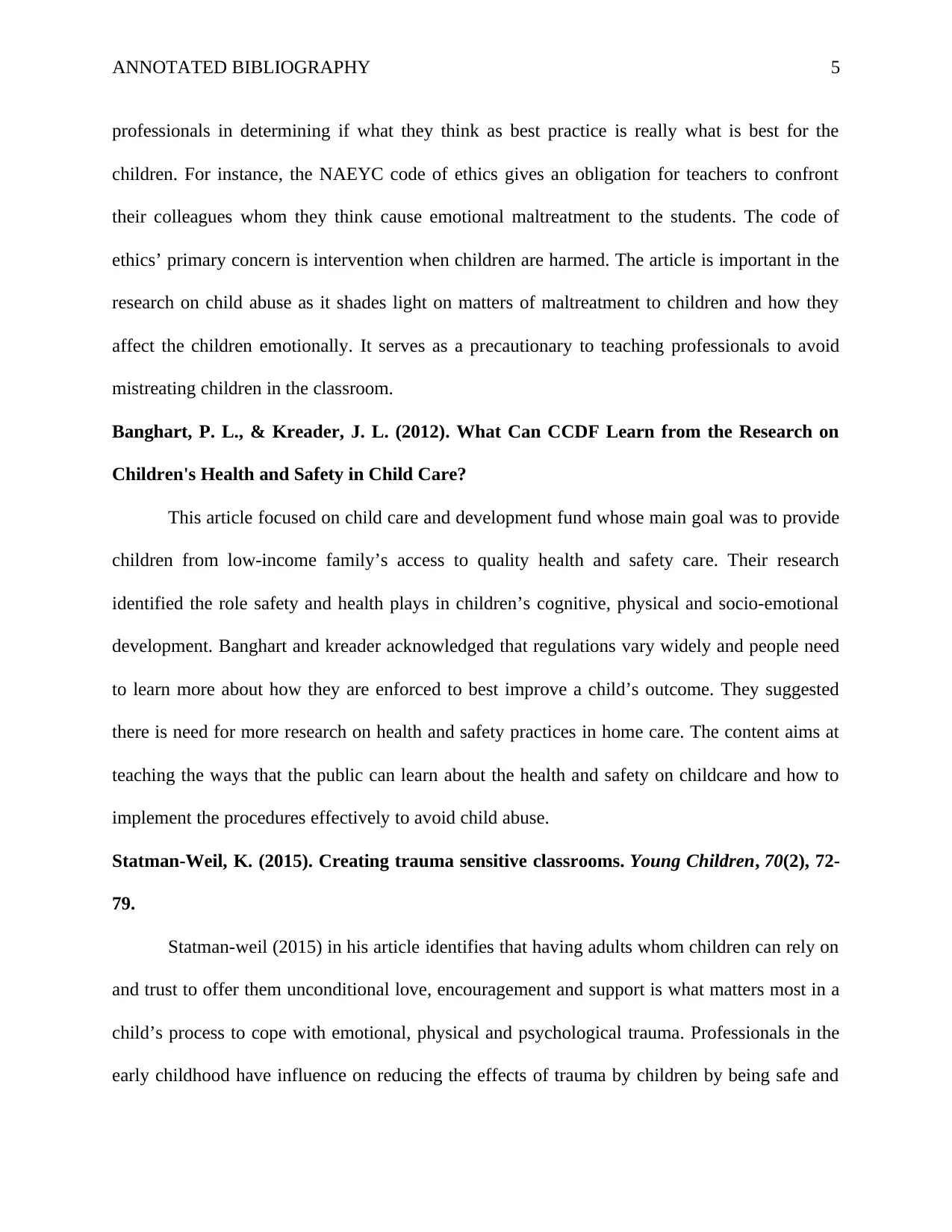
ANNOTATED BIBLIOGRAPHY 5
professionals in determining if what they think as best practice is really what is best for the
children. For instance, the NAEYC code of ethics gives an obligation for teachers to confront
their colleagues whom they think cause emotional maltreatment to the students. The code of
ethics’ primary concern is intervention when children are harmed. The article is important in the
research on child abuse as it shades light on matters of maltreatment to children and how they
affect the children emotionally. It serves as a precautionary to teaching professionals to avoid
mistreating children in the classroom.
Banghart, P. L., & Kreader, J. L. (2012). What Can CCDF Learn from the Research on
Children's Health and Safety in Child Care?
This article focused on child care and development fund whose main goal was to provide
children from low-income family’s access to quality health and safety care. Their research
identified the role safety and health plays in children’s cognitive, physical and socio-emotional
development. Banghart and kreader acknowledged that regulations vary widely and people need
to learn more about how they are enforced to best improve a child’s outcome. They suggested
there is need for more research on health and safety practices in home care. The content aims at
teaching the ways that the public can learn about the health and safety on childcare and how to
implement the procedures effectively to avoid child abuse.
Statman-Weil, K. (2015). Creating trauma sensitive classrooms. Young Children, 70(2), 72-
79.
Statman-weil (2015) in his article identifies that having adults whom children can rely on
and trust to offer them unconditional love, encouragement and support is what matters most in a
child’s process to cope with emotional, physical and psychological trauma. Professionals in the
early childhood have influence on reducing the effects of trauma by children by being safe and
professionals in determining if what they think as best practice is really what is best for the
children. For instance, the NAEYC code of ethics gives an obligation for teachers to confront
their colleagues whom they think cause emotional maltreatment to the students. The code of
ethics’ primary concern is intervention when children are harmed. The article is important in the
research on child abuse as it shades light on matters of maltreatment to children and how they
affect the children emotionally. It serves as a precautionary to teaching professionals to avoid
mistreating children in the classroom.
Banghart, P. L., & Kreader, J. L. (2012). What Can CCDF Learn from the Research on
Children's Health and Safety in Child Care?
This article focused on child care and development fund whose main goal was to provide
children from low-income family’s access to quality health and safety care. Their research
identified the role safety and health plays in children’s cognitive, physical and socio-emotional
development. Banghart and kreader acknowledged that regulations vary widely and people need
to learn more about how they are enforced to best improve a child’s outcome. They suggested
there is need for more research on health and safety practices in home care. The content aims at
teaching the ways that the public can learn about the health and safety on childcare and how to
implement the procedures effectively to avoid child abuse.
Statman-Weil, K. (2015). Creating trauma sensitive classrooms. Young Children, 70(2), 72-
79.
Statman-weil (2015) in his article identifies that having adults whom children can rely on
and trust to offer them unconditional love, encouragement and support is what matters most in a
child’s process to cope with emotional, physical and psychological trauma. Professionals in the
early childhood have influence on reducing the effects of trauma by children by being safe and
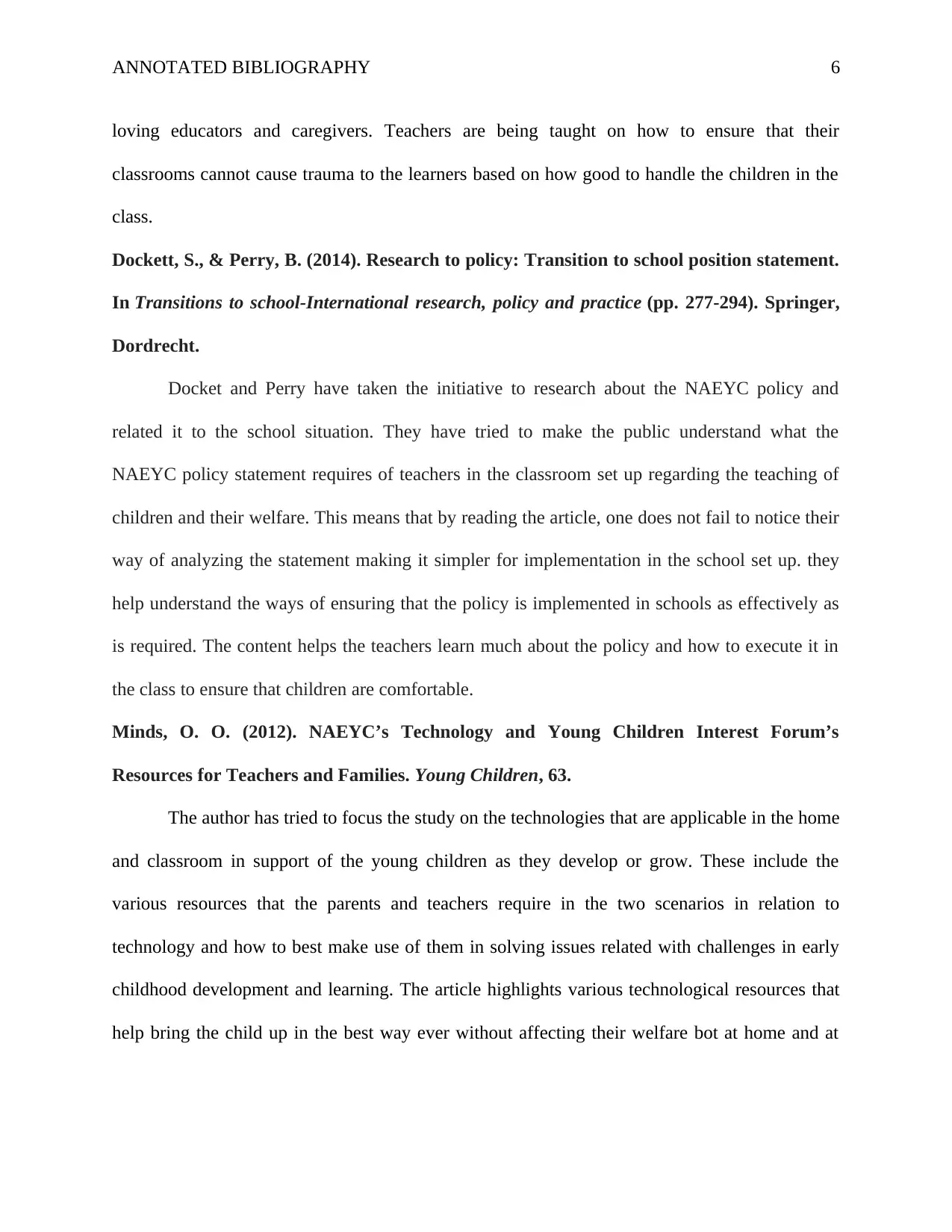
ANNOTATED BIBLIOGRAPHY 6
loving educators and caregivers. Teachers are being taught on how to ensure that their
classrooms cannot cause trauma to the learners based on how good to handle the children in the
class.
Dockett, S., & Perry, B. (2014). Research to policy: Transition to school position statement.
In Transitions to school-International research, policy and practice (pp. 277-294). Springer,
Dordrecht.
Docket and Perry have taken the initiative to research about the NAEYC policy and
related it to the school situation. They have tried to make the public understand what the
NAEYC policy statement requires of teachers in the classroom set up regarding the teaching of
children and their welfare. This means that by reading the article, one does not fail to notice their
way of analyzing the statement making it simpler for implementation in the school set up. they
help understand the ways of ensuring that the policy is implemented in schools as effectively as
is required. The content helps the teachers learn much about the policy and how to execute it in
the class to ensure that children are comfortable.
Minds, O. O. (2012). NAEYC’s Technology and Young Children Interest Forum’s
Resources for Teachers and Families. Young Children, 63.
The author has tried to focus the study on the technologies that are applicable in the home
and classroom in support of the young children as they develop or grow. These include the
various resources that the parents and teachers require in the two scenarios in relation to
technology and how to best make use of them in solving issues related with challenges in early
childhood development and learning. The article highlights various technological resources that
help bring the child up in the best way ever without affecting their welfare bot at home and at
loving educators and caregivers. Teachers are being taught on how to ensure that their
classrooms cannot cause trauma to the learners based on how good to handle the children in the
class.
Dockett, S., & Perry, B. (2014). Research to policy: Transition to school position statement.
In Transitions to school-International research, policy and practice (pp. 277-294). Springer,
Dordrecht.
Docket and Perry have taken the initiative to research about the NAEYC policy and
related it to the school situation. They have tried to make the public understand what the
NAEYC policy statement requires of teachers in the classroom set up regarding the teaching of
children and their welfare. This means that by reading the article, one does not fail to notice their
way of analyzing the statement making it simpler for implementation in the school set up. they
help understand the ways of ensuring that the policy is implemented in schools as effectively as
is required. The content helps the teachers learn much about the policy and how to execute it in
the class to ensure that children are comfortable.
Minds, O. O. (2012). NAEYC’s Technology and Young Children Interest Forum’s
Resources for Teachers and Families. Young Children, 63.
The author has tried to focus the study on the technologies that are applicable in the home
and classroom in support of the young children as they develop or grow. These include the
various resources that the parents and teachers require in the two scenarios in relation to
technology and how to best make use of them in solving issues related with challenges in early
childhood development and learning. The article highlights various technological resources that
help bring the child up in the best way ever without affecting their welfare bot at home and at
⊘ This is a preview!⊘
Do you want full access?
Subscribe today to unlock all pages.

Trusted by 1+ million students worldwide
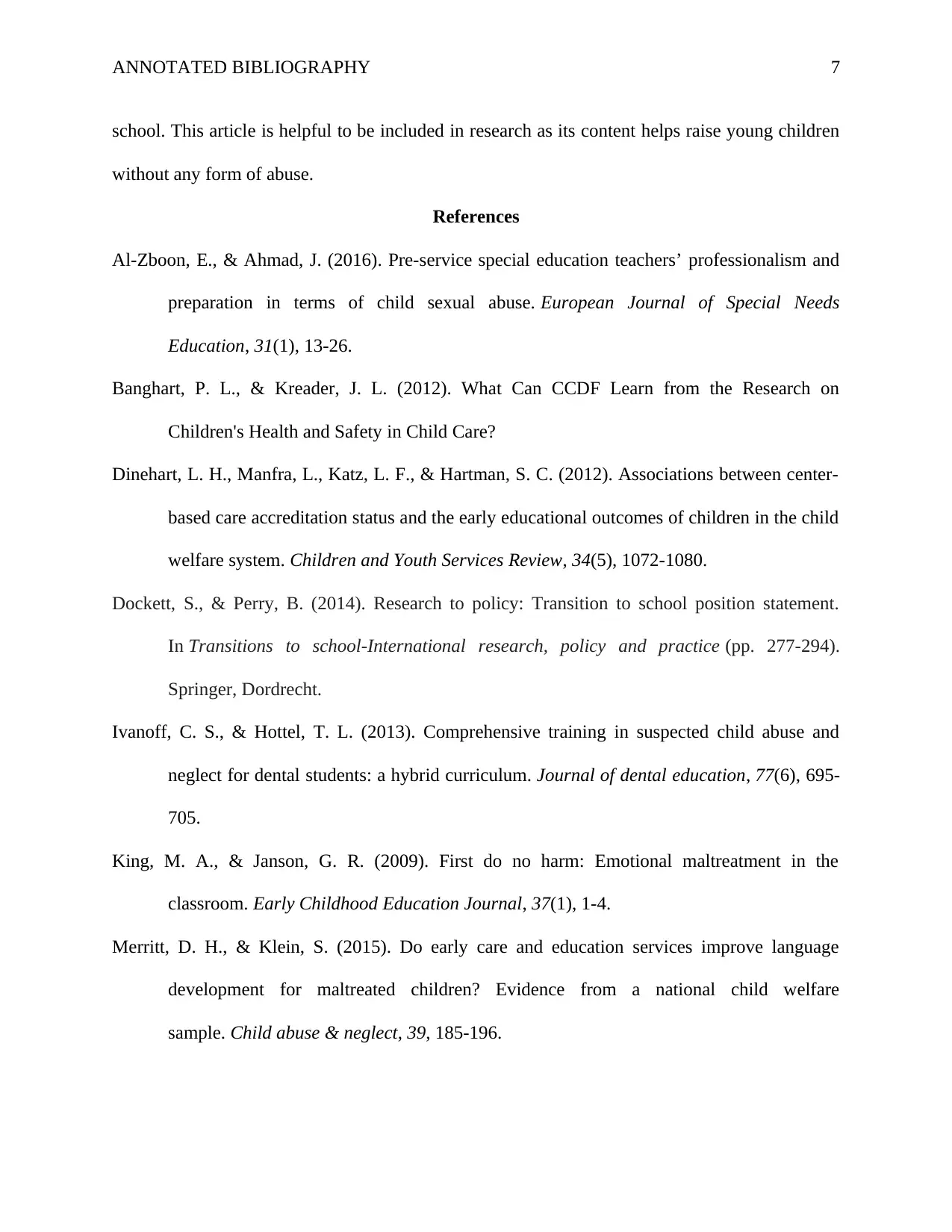
ANNOTATED BIBLIOGRAPHY 7
school. This article is helpful to be included in research as its content helps raise young children
without any form of abuse.
References
Al-Zboon, E., & Ahmad, J. (2016). Pre-service special education teachers’ professionalism and
preparation in terms of child sexual abuse. European Journal of Special Needs
Education, 31(1), 13-26.
Banghart, P. L., & Kreader, J. L. (2012). What Can CCDF Learn from the Research on
Children's Health and Safety in Child Care?
Dinehart, L. H., Manfra, L., Katz, L. F., & Hartman, S. C. (2012). Associations between center-
based care accreditation status and the early educational outcomes of children in the child
welfare system. Children and Youth Services Review, 34(5), 1072-1080.
Dockett, S., & Perry, B. (2014). Research to policy: Transition to school position statement.
In Transitions to school-International research, policy and practice (pp. 277-294).
Springer, Dordrecht.
Ivanoff, C. S., & Hottel, T. L. (2013). Comprehensive training in suspected child abuse and
neglect for dental students: a hybrid curriculum. Journal of dental education, 77(6), 695-
705.
King, M. A., & Janson, G. R. (2009). First do no harm: Emotional maltreatment in the
classroom. Early Childhood Education Journal, 37(1), 1-4.
Merritt, D. H., & Klein, S. (2015). Do early care and education services improve language
development for maltreated children? Evidence from a national child welfare
sample. Child abuse & neglect, 39, 185-196.
school. This article is helpful to be included in research as its content helps raise young children
without any form of abuse.
References
Al-Zboon, E., & Ahmad, J. (2016). Pre-service special education teachers’ professionalism and
preparation in terms of child sexual abuse. European Journal of Special Needs
Education, 31(1), 13-26.
Banghart, P. L., & Kreader, J. L. (2012). What Can CCDF Learn from the Research on
Children's Health and Safety in Child Care?
Dinehart, L. H., Manfra, L., Katz, L. F., & Hartman, S. C. (2012). Associations between center-
based care accreditation status and the early educational outcomes of children in the child
welfare system. Children and Youth Services Review, 34(5), 1072-1080.
Dockett, S., & Perry, B. (2014). Research to policy: Transition to school position statement.
In Transitions to school-International research, policy and practice (pp. 277-294).
Springer, Dordrecht.
Ivanoff, C. S., & Hottel, T. L. (2013). Comprehensive training in suspected child abuse and
neglect for dental students: a hybrid curriculum. Journal of dental education, 77(6), 695-
705.
King, M. A., & Janson, G. R. (2009). First do no harm: Emotional maltreatment in the
classroom. Early Childhood Education Journal, 37(1), 1-4.
Merritt, D. H., & Klein, S. (2015). Do early care and education services improve language
development for maltreated children? Evidence from a national child welfare
sample. Child abuse & neglect, 39, 185-196.
Paraphrase This Document
Need a fresh take? Get an instant paraphrase of this document with our AI Paraphraser
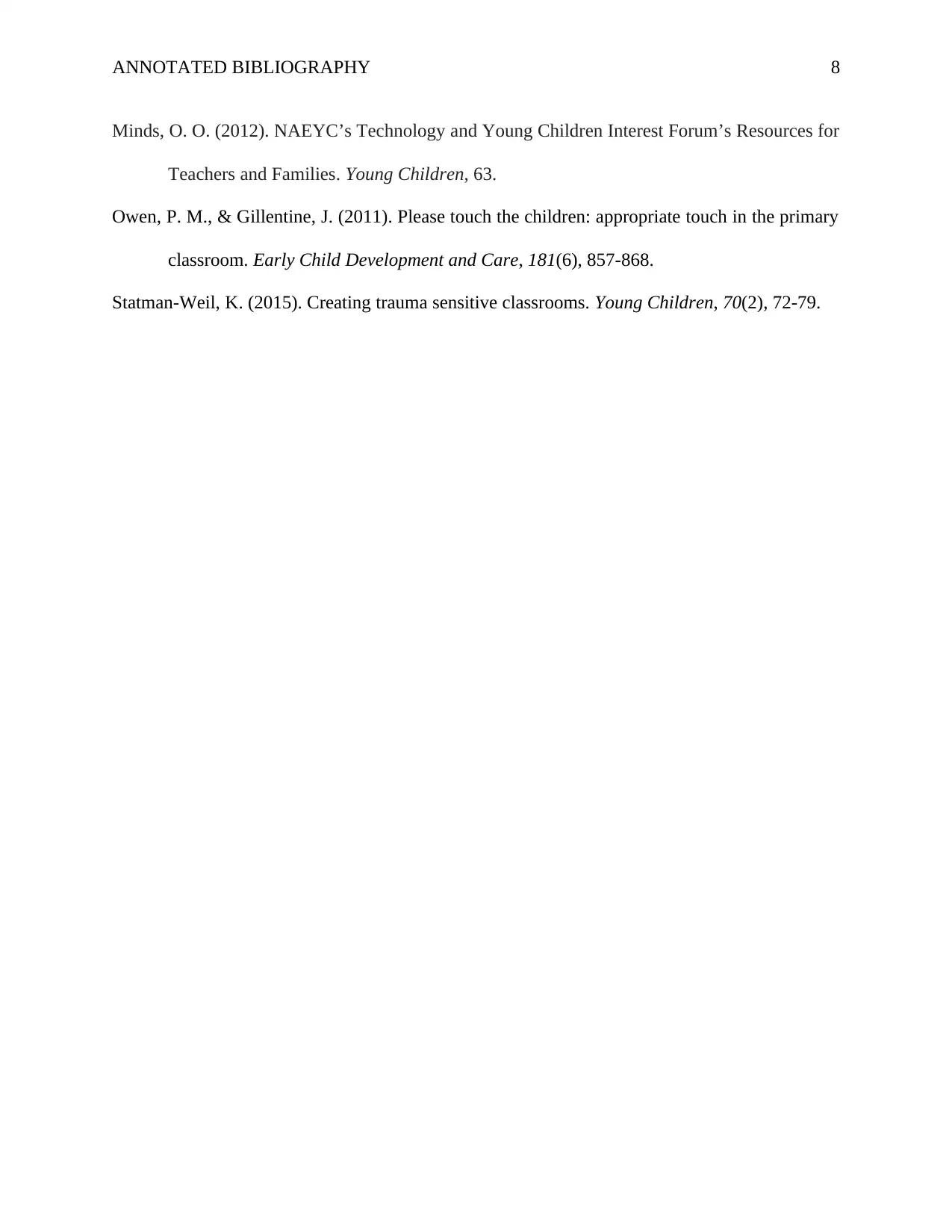
ANNOTATED BIBLIOGRAPHY 8
Minds, O. O. (2012). NAEYC’s Technology and Young Children Interest Forum’s Resources for
Teachers and Families. Young Children, 63.
Owen, P. M., & Gillentine, J. (2011). Please touch the children: appropriate touch in the primary
classroom. Early Child Development and Care, 181(6), 857-868.
Statman-Weil, K. (2015). Creating trauma sensitive classrooms. Young Children, 70(2), 72-79.
Minds, O. O. (2012). NAEYC’s Technology and Young Children Interest Forum’s Resources for
Teachers and Families. Young Children, 63.
Owen, P. M., & Gillentine, J. (2011). Please touch the children: appropriate touch in the primary
classroom. Early Child Development and Care, 181(6), 857-868.
Statman-Weil, K. (2015). Creating trauma sensitive classrooms. Young Children, 70(2), 72-79.
1 out of 8
Your All-in-One AI-Powered Toolkit for Academic Success.
+13062052269
info@desklib.com
Available 24*7 on WhatsApp / Email
![[object Object]](/_next/static/media/star-bottom.7253800d.svg)
Unlock your academic potential
Copyright © 2020–2025 A2Z Services. All Rights Reserved. Developed and managed by ZUCOL.
